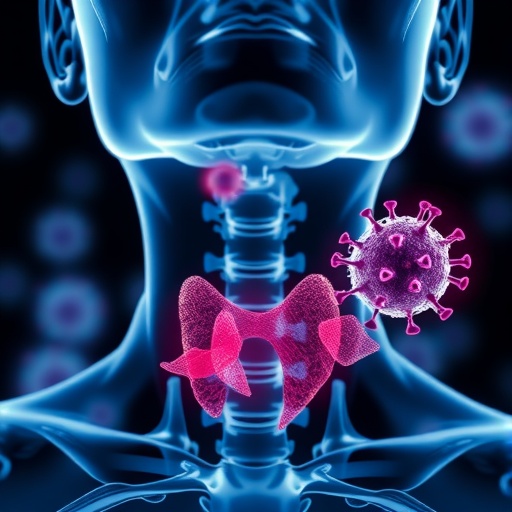The University of Texas MD Anderson Cancer Center continues to spearhead transformative advances in oncological research, with its latest breakthroughs promising to reshape cancer treatment paradigms across multiple tumor types. Combining state-of-the-art clinical trials and cutting-edge molecular technologies, these innovative studies highlight significant progress in treating pancreatic, colorectal, kidney, breast, stomach, and testicular cancers, alongside novel insights into biomarkers predictive of metastasis in oral cancer.
A notable clinical trial led by Drs. Chad Tang and Pavlos Msaouel has demonstrated the potential of metastasis-directed targeted radiation therapy to delay systemic treatment initiation in patients with oligometastatic clear cell renal cell carcinoma (ccRCC). This Phase II trial enrolled 121 patients, achieving impressive two- and three-year survival rates of 94% and 87%, respectively. Patients were able to avoid systemic therapies — such as immunotherapy and targeted agents, which often pose considerable side effects — for a median of 34 months. Integral to this approach was the use of a novel circulating tumor DNA (ctDNA) assay, which detected minimal residual disease, enabling clinicians to stratify patients based on likelihood of treatment failure. Those without detectable ctDNA remained off systemic therapy twice as long as their counterparts, underscoring the test’s promise as a noninvasive biomarker and patient selection tool.
In parallel, immunotherapeutic innovation continues with the cancer vaccine ELI-002, co-led by Dr. Shubham Pant, targeting KRAS-mutated pancreatic and colorectal cancers. The vaccine is designed to provoke robust T-cell responses against tumor-specific neoantigens localized within lymph nodes, a critical site for anti-tumor immunity induction. Long-term data from the AMPLIFY-201 trial reveal that 68% of patients mounted strong T-cell reactivity correlated with prolonged relapse-free survival; notably, median recurrence-free survival had not been reached even at 24 months post-treatment. These promising results have catalyzed a Phase II trial incorporating an expanded vaccine formulation (ELI-002 7P) aimed at additional KRAS mutations, a key driver mutation historically challenging to target.
Challenges in treatment-resistant colorectal cancer have been tackled through a novel triple combination strategy targeting microsatellite stable (MSS) BRAF V600E-mutant metastatic colorectal cancer, as investigated by Dr. Van Morris and colleagues. The BRAF V600E mutation confers aggressive phenotypes with dismal prognoses and limited therapeutic options. While FDA-approved targeted agents such as encorafenib and cetuximab exist, their efficacy is often time-limited. The addition of the PD-1 immune checkpoint inhibitor nivolumab in a Phase I/II trial yielded a 50% overall response rate and a median progression-free survival exceeding seven months. Liquid biopsy-based RNA analyses further elucidated distinct molecular signatures differentiating responders, bolstering personalized treatment stratification and seeding a nationwide Phase II trial (SWOG S2107).
At the forefront of understanding tumor heterogeneity, Dr. Nicholas Navin’s team has unveiled a groundbreaking single-cell sequencing platform, wellDR-seq, enabling the simultaneous capture of DNA and RNA profiles within individual breast cancer cells. This technology permits unprecedented molecular dissection of chromosomal alterations and transcriptional regulation in estrogen receptor-positive breast tumors. Profiling 33,646 cells, the researchers mapped the clonal evolution and gene expression dynamics underpinning tumor initiation and progression. These insights not only illuminate pathways driving invasive and aggressive phenotypes but also hold potential for broader application across diverse diseases where cellular heterogeneity is relevant.
Another stride in precision medicine emerged from Yuan-Hung Lo’s team, who leveraged CRISPR gene editing within human-derived stomach organoids to elucidate gene-drug interactions that modulate cisplatin chemotherapy sensitivity. The high-throughput CRISPR screening identified an unexpected link between cellular fucosylation — a sugar modification process — and cisplatin cytotoxicity, highlighting the TAF6L gene as a central orchestrator of cellular recovery mechanisms. These findings underscore the power of organoid CRISPR platforms to uncover novel therapeutic targets and predictive biomarkers that may refine chemotherapeutic regimens.
On the frontier of targeted therapeutics, a collaboration involving Drs. Kathleen McAndrews, Anirban Maitra, Raghu Kalluri, and Timothy Heffernan has characterized BI-2493, a first-in-class pan-KRAS inhibitor demonstrating robust antitumor efficacy in preclinical models. Unlike existing KRAS inhibitors, BI-2493 targets a broad spectrum of KRAS mutants, overcoming the limitation of allele specificity. In pancreatic cancer models, BI-2493 suppressed tumor proliferation and activated immune microenvironment remodeling by increasing the infiltration of immune effector cells while diminishing immunosuppressive myeloid populations. These results reveal mechanistic synergy between direct oncogenic signaling blockade and enhanced immunotherapy responsiveness, paving the way for combinatorial approaches targeting KRAS-driven malignancies.
Addressing a critical unmet need in germ-cell tumors, Dr. Yago Nieto led a Phase II trial evaluating high-dose chemotherapy combined with bevacizumab, specifically targeting DNA damage repair pathways in multiply relapsed or refractory testicular cancers. Despite high initial cure rates with cisplatin-based chemotherapy, a subset of patients face poor prognoses upon relapse. The trial’s five-year relapse-free and overall survival rates exceeded expectations at 54% and 55.5%, confirming the value of intensifying DNA repair-targeted approaches. Although bevacizumab addition did not enhance outcomes, validation through a larger prospective cohort reinforces the scientific rationale for pursuing DNA repair modulation in this population.
Innovations are also improving surgical oncology through enhanced detection of pre-cancerous lesions. Dr. Charles Manning’s laboratory developed V-1520, a near-infrared fluorescent tracer targeting a protein biomarker enriched in tumor-associated macrophages within pancreatic cancer microenvironments. This probe allows intraoperative visualization of high-risk pre-malignant lesions, facilitating complete resection and potentially reducing recurrence. Importantly, V-1520 selectively binds to inflammatory signatures linked to malignancy but not benign pancreatitis, demonstrating specificity that could be translated to other tumor types, augmenting precision surgical interventions.
In the realm of molecular diagnostics, Dr. Koichi Takahashi and colleagues have identified predictive biomarkers for oral cancer metastasis by mapping the tumor microenvironment with high spatial resolution. They discovered that elevated presence of myofibroblastic cancer-associated fibroblasts (myCAFs) at the invasive tumor front correlates with enhanced lymph node metastasis and poorer prognosis. These myCAFs appear to act as “accomplices,” supporting cancer cell dissemination. A 23-gene spatial molecular signature derived from this study enables early prediction of metastasis potential, highlighting the complex interplay between tumor cells and their microenvironment and opening avenues for targeted stromal therapies.
These multiple breakthroughs cement MD Anderson’s role at the vanguard of cancer research, bridging molecular insights with translational impact. The ongoing integration of genomic technologies, immunotherapy, targeted agents, and innovative clinical trial designs epitomizes a new era in oncology, offering hope for durable remissions and improved survival across diverse cancer types.
Subject of Research: Cancer research spanning pancreatic, colorectal, kidney, breast, stomach, testicular, and oral cancers with focus on targeted therapies, immunotherapy vaccines, molecular diagnostics, and tumor microenvironment.
Article Title: MD Anderson’s 2025 Research Highlights: Breakthroughs in Cancer Therapeutics and Molecular Insights
News Publication Date: September 5, 2025
Web References:
https://www.mdanderson.org/newsroom/research-highlights.html
https://www.mdanderson.org/newsroom/research-highlights/targeted-radiation-helps-patients-with-kidney-cancer-delay-systemic-therapy.h00-159779601.html
https://www.mdanderson.org/newsroom/research-highlights/final-trial-data-from-eli-002-cancer-immunotherapy-vaccine-reinforce-promising-results.h00-159778812.html
https://www.mdanderson.org/newsroom/research-highlights/triple-combination-therapy-shows-promise-for-treatment-resistant-microsatellite-stable-BRAF-V600E-mutant-metastatic-colorectal-cancer.h00-159778812.html
https://www.mdanderson.org/newsroom/research-highlights/novel-sequencing-technology-links-dna-and-rna-to-provide-molecular-insights-into-breast-cancer-progression.h00-159779601.html
https://www.mdanderson.org/newsroom/research-highlights/large-scale-crispr-screening-in-stomach-organoids-reveals-gene-drug-interactions.h00-159778812.html
https://www.mdanderson.org/newsroom/research-highlights/first-in-class-pan-kras-inhibitor-shows-strong-antitumor-activity-in-preclinical-models.h00-159779601.html
https://www.mdanderson.org/newsroom/research-highlights/high-dose-chemotherapy-improves-outcomes-for-multiply-relapsed-and-refractory-germ-cell-tumors.h00-159778812.html
https://www.mdanderson.org/newsroom/research-highlights/fluorescent-tracer-helps-identify-precancerous-lesions-in-pancreatic-cancer-models.h00-159778812.html
https://www.mdanderson.org/newsroom/research-highlights/researchers-identify-predictive-biomarkers-for-oral-cancer-metastasis.h00-159779601.html
References:
See associated journal publications in The Lancet Oncology, Nature Medicine, Cancer Cell, Cell, Nature Communications, Science Translational Medicine, Clinical Cancer Research, and PLOS Genetics linked in the web references.
Keywords:
Cancer research, Pancreatic cancer, Stomach cancer, Colorectal cancer, Oral cancer, Breast cancer, Cancer genomics, Genome sequencing, Biomarkers, Cancer immunotherapy, Chemotherapy, Radiation therapy
Tags: biomarkers in cancer metastasisbreast cancer therapeutic developmentscirculating tumor DNA assayclinical trials in cancer treatmentcolorectal cancer research highlightskidney cancer clinical study outcomesMD Anderson Cancer Center breakthroughsnoninvasive cancer diagnostic techniquesoligometastatic clear cell renal cell carcinomaoncological research advancementspancreatic cancer treatment innovationstargeted radiation therapy for cancer





